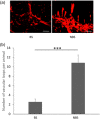Hypophysial angiogenesis decodes annual time and underlies physiological adaptation to seasonal changes in the environment
- PMID: 35844178
- PMCID: PMC9796326
- DOI: 10.1002/jez.2639
Hypophysial angiogenesis decodes annual time and underlies physiological adaptation to seasonal changes in the environment
Abstract
Adaptation to annual changes in the environment is controlled by hypophysial hormones. In temperate zones, photoperiod is the primary external cue that regulates annual biological cycles and is translated by the pattern of melatonin secretion acting primarily in the hypophysial pars tuberalis. Angiogenic mechanisms within this tissue contribute to decode the melatonin signal through alternative splicing of the vascular endothelial growth factor A (VEGF-A) gene in both the pars tuberalis and the capillary loops of the infundibulum. The resulting melatonin-evoked differential productions of VEGF-A isoforms will induce seasonal remodeling of the vascular connection between the hypothalamus and hypophysis, and act as paracrine messengers in the pars distalis to generate the required seasonal endocrine response. Specifically, the long melatonin signal in winter upregulates antiangiogenic VEGF-A isoforms, which will reduce the number of vascular loops and the density of VEGF receptors in endocrine and folliculo-stellate (FS) cells, inhibit prolactin secretion, and stimulate FSH. In contrast, the short melatonin signal in summer upregulates proangiogenic VEGF-A isoforms that will increase the number of vascular loops and the density of VEGF receptors in endocrine and FS cells, stimulate prolactin secretion, and suppress FSH. A similar system has been identified in long day seasonal breeders, revealing that this is a conserved mechanism of adaptation across species. Thus, an angiogenesis-based, intrahypophysial system for annual time measurement controls local microvascular plasticity and conveys the photoperiodic signal readout from the melatonin sensitive pars tuberalis to the endocrine cells of the pars distalis to regulate seasonal adaptation to the environment.
Keywords: VEGE-A; angiogenesis; melatonin; pars tuberalis; photoperiod; pituitary gland; prolactin.
© 2022 The Authors. Journal of Experimental Zoology Part A: Ecological Genetics and Physiology published by Wiley Periodicals LLC.
Conflict of interest statement
The author declares no conflict of interest.
Figures



Similar articles
-
Mechanisms regulating angiogenesis underlie seasonal control of pituitary function.Proc Natl Acad Sci U S A. 2017 Mar 21;114(12):E2514-E2523. doi: 10.1073/pnas.1618917114. Epub 2017 Mar 7. Proc Natl Acad Sci U S A. 2017. PMID: 28270617 Free PMC article.
-
Signaling pathways to and from the hypophysial pars tuberalis, an important center for the control of seasonal rhythms.Gen Comp Endocrinol. 2018 Mar 1;258:236-243. doi: 10.1016/j.ygcen.2017.05.011. Epub 2017 May 13. Gen Comp Endocrinol. 2018. PMID: 28511899 Review.
-
Photoperiodic regulation of prolactin gene expression in the Syrian hamster by a pars tuberalis-derived factor.J Neuroendocrinol. 2001 Feb;13(2):147-57. doi: 10.1046/j.1365-2826.2001.00611.x. J Neuroendocrinol. 2001. PMID: 11168840
-
Cell and molecular biology of the pars tuberalis of the pituitary.Int Rev Cytol. 1999;185:157-94. doi: 10.1016/s0074-7696(08)60151-5. Int Rev Cytol. 1999. PMID: 9750267 Review.
-
Cells co-expressing luteinising hormone and thyroid-stimulating hormone are present in the ovine pituitary pars distalis but not the pars tuberalis: implications for the control of endogenous circannual rhythms of prolactin.Neuroendocrinology. 2013;97(4):355-62. doi: 10.1159/000350790. Epub 2013 May 23. Neuroendocrinology. 2013. PMID: 23548370
References
-
- Acosta, M. & Mohamed, F. (2009). Pituitary pars intermedia of male viscacha (Lagostomus maximus maximus): A morphometric study of seasonal and age‐related changes in immunohistochemistry. Cells Tissues Organs, 190, 219–229. - PubMed
-
- Acosta, M. & Mohamed, F. (2011). Effect of the photoperiod and administration of melatonin on folliculostellate cells of the pituitary pars distalis of adult male viscacha (Lagostomus maximus maximus). Acta Histochemica, 113, 640–646. - PubMed
-
- Allaerts, W. , Engelborghs, Y. , Vanoostveldt, P. , & Denef, C. (1990). Evidence that folliculostellate cells do not impede the permeability of intercellular spaces to molecular diffusion in three‐dimensinal aggregate cell cultures of the rat anterior pituitary. Endocrinology, 127, 1517–1525. - PubMed
-
- Allaerts, W. & Vankelecom, H. (2005). History and perspectives of pituitary folliculo‐stellate cell research. European Journal of Endocrinology, 153, 1–12. - PubMed
Publication types
MeSH terms
Substances
Grants and funding
LinkOut - more resources
Full Text Sources
Miscellaneous

